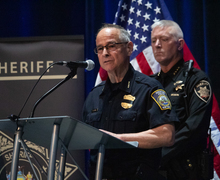Vernon Jordan draws parallels between current political climate and civil rights era in 2017 commencement speech
Codie Yan | Staff Photographer
Jordan spent much of his speech describing his life growing up during the civil rights era and his relationship with former Alabama Gov. George Wallace.
UPDATED: May 15, 2017 at 1:41 a.m.
Vernon Jordan Jr. — a prominent civil rights activist, lawyer and business executive — spoke about the challenges he faced as a black student in the 1950s and the current civil rights challenges in the United States in his speech to Syracuse University’s 2017 class Sunday morning.
During the speech, Jordan drew parallels between President Donald Trump’s anti-immigrant rhetoric and racist sentiments expressed by politicians in the South more than 60 years ago.
Courtesy of Vernon Jordan

“When executive orders bar people from our shores based on what they look like or how they worship, it is hard not to hear echoes of then-U.S. Sen. Strom Thurmond (R-S.C.) on the campaign trail in 1948 or the cry of George Wallace at the schoolhouse door in 1963 saying, ‘segregation today, tomorrow, forever,’” Jordan said. “We have been here before.”
Jordan spent much of his speech describing his life growing up during the civil rights era and his relationship with former Alabama Gov. George Wallace.
He spoke about his childhood in Georgia, where he attended an ill-equipped, overcrowded and segregated high school. He said the per-pupil expenditure was $4 for white students for every $1 for black students. His high school’s chemistry lab had a single Bunsen burner and the geometry textbook he used in 1951 had been used by white students in 1935, he said.
When he applied to college in Georgia in 1952, he said every institution in the state was segregated. He ended up attending DePauw University in Indiana, but was the only black student in his class.
In 1957, the same year Jordan graduated from DePauw, then-Sen. John F. Kennedy gave the commencement speech at SU, urging the university’s graduates to consider entering politics.
While Kennedy was encouraging Americans to enter politics, Jordan said many black Americans were struggling to get an education and a job. After Jordan graduated college, he said he was convinced he would spend his summer working at an office. Instead, he drove city buses in Chicago.
That same summer, Thurmond filibustered the Civil Rights Act of 1957 after speaking on the Senate floor for over 24 hours.
“We were years away, and a world away, from the Civil Rights Act of 1964, the Voting Rights Act of 1965 or the Housing Act of 1968,” Jordan said in his speech Sunday.
Even though Jordan’s parents were good citizens and his brothers fought in WWII, he said Georgia gave aid to black students willing to travel out-of-state to receive their education. Georgia at the time preferred to “pay for black students to go to another state than educate us in our home state,” Jordan added.
Despite the challenges Jordan faced as a black American in the civil rights era, he said people have the ability to transform. After he was shot by a white supremacist in 1980, Jordan said the first message he read was from Wallace, who had served as Alabama’s governor from 1963-67 and from 1971-79.
In the message to Jordan, Wallace — who at one time promised to keep segregation “forever,” and who personally stood at the entrance to an auditorium at the University of Alabama to block black students’ entry — said he would pray for Jordan’s complete recovery and was thankful that his life had been spared.
Although Jordan said he fought against everything Wallace stood for, he said he appreciated the message.
“It said to me that political differences must be subordinated to common humanity,” Jordan said. “It said to me that we are all human beings who have to reach out to each other.”
Later, Jordan met Wallace while attending the retirement ceremony of E.D. Nixon, another civil rights activist. Wallace had been confined to a wheelchair after surviving an assassination attempt. Jordan said Wallace asked him to reach down and hug him.
“The villain of Selma … who once stood in the schoolhouse door to keep black people out, could no longer stand at all. Yet he wished he could stand, not to set to set himself defiantly or thwart history, but rather to embrace me as a brother,” Jordan said in his speech.
He added his experience with Wallace is a reminder that the road to change is long, but possible.
Jordan also urged SU’s Class of 2017 to follow the examples of Jim Brown and Kathrine Switzer, two SU graduates who helped advance opportunities for blacks and women, respectively.
Brown — who received All-America honors playing football for Syracuse and was eventually inducted into the NFL Hall of Fame — helped establish the Negro Industrial and Economic Union and the Amer-I-Can program. The Amer-I-can program helps gang members, former inmates and at-risk young people learn essential life skills.
After being told women could not run in the Boston Marathon, Switzer registered for the 1967 race with just her initials and completed the run despite a race official’s attempt to rip her running number off.
Jordan encouraged the graduating class to run like Brown and Switzer, though not necessarily in an athletic sense.
“Whatever you do, run towards justice, run into the fire, because the fight for justice is not a sprint, or even a marathon, but a relay race in which your generation now has the baton,” Jordan said. “It is up to you to protect the progress we made and advance that progress into the future.”
CORRECTION: In a previous version of this post, the time in which former Alabama Gov. George Wallace served the state in that role was misstated. Wallace was not governor of Alabama when Vernon Jordan was shot.
CORRECTION: In a previous version of this post, Vernon Jordan was misquoted. Jordan said the “fight for justice is not a sprint.”
Published on May 14, 2017 at 2:04 pm
Contact Jordan: jmulle01@syr.edu | @jordanmuller18




